Coaches who listen carefully, speak clearly, and give caring feedback build trust with their clients faster. If a coach focuses on improving just these three skills, their conversations will lead to better results and client satisfaction.
–
For the 3-minute mirror method, jump to this section.
For the 10-word rule, go here.
–
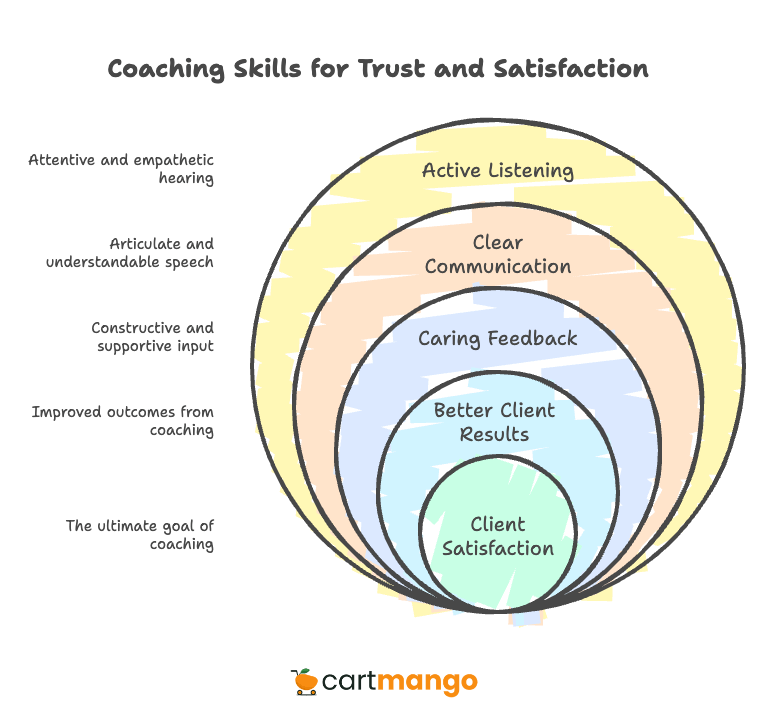
How Important Are Communication Skills?
Many clients stop working with a coach because of poor communication.
According to experts in the coaching industry, when coaches and clients don’t communicate well, it creates mismatched expectations, which is the main reason coaches lose clients.
Your communication style directly impacts client results. Clear messaging accelerates progress while confusion stalls momentum.
Core Skill #1: Active Listening
I used to think listening meant staying quiet while clients talked. That approach missed the real work happening beneath surface conversations.
Real listening involves 4 specific behaviors:

- First, paraphrase what you hear using their exact words.
- Second, embrace strategic silence instead of jumping in with solutions.
- Third, ask clarifying questions that start with “What” or “How.”
- Fourth, label emotions out loud.
3-Minute Mirror Method
Here’s how the 3-Minute Mirror Method works:
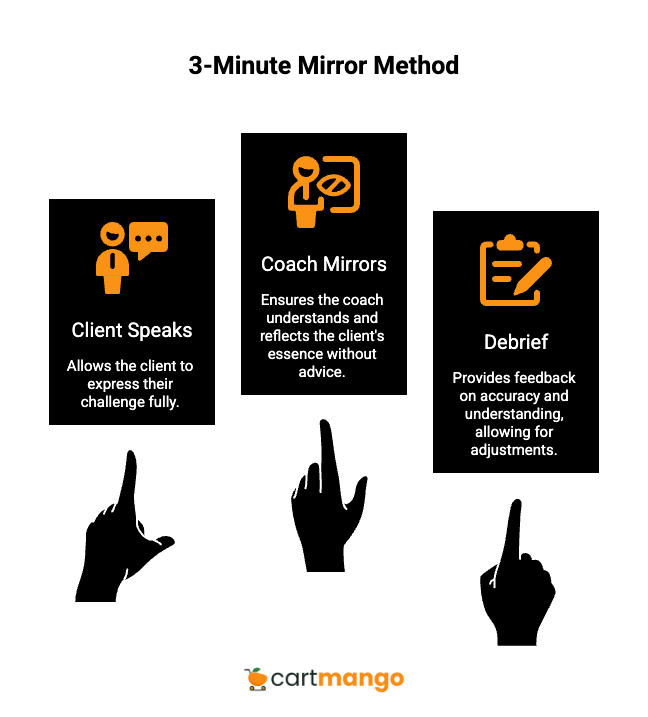
1/ Client speaks about a challenge (1 min).
2/ Coach mirrors essence (1 min) – no advice.
3/ Debrief (1 min): accuracy, felt understood, tweak.
Accuracy: Did you mirror back what the client actually said? The client confirms whether you captured the key points correctly or missed something important.
Felt understood: This is about the emotional impact. Did the client feel truly heard and validated by your mirroring? It’s not just about getting the facts right, but whether the client felt you “got” them on a deeper level.
Tweak: What should be adjusted for the next round? Maybe you need to slow down, use more of the client’s exact words, or pick up on emotional cues you missed.
–
A parenting coach can use this technique when working with frustrated parents. Instead of offering advice immediately, they mirror back phrases like “You feel completely overwhelmed when bedtime becomes a two-hour battle.” The parent instantly feels heard.
Finance coaches can apply the same approach. When a client says “I’m terrified of checking my bank account,” mirror it back: “Looking at your account balance brings up real fear for you.”
Listening Scorecard
Behaviour Tracked | ✅ /❌ | Notes (example) |
|---|---|---|
Paraphrased client’s key point | ✅ | “So you’re saying the morning routine feels chaotic” |
2-second pause before replying | ❌ | Jumped in too quickly with solutions |
Asked clarifying “What/How” question | ✅ | “What makes mornings feel most overwhelming?” |
Labeled emotion (“Sounds…”) | ✅ | “That sounds really frustrating” |
Summarised session ≤25 words | ✅ | “Create 15-min morning buffer, prep night before, start with easiest task” |
Example: After a session with a business coach struggling with client boundaries, your scorecard might show 4 out of 5 behaviors completed, with the note “Need to pause more before responding to boundary violations.”
Track one “aha” phrase from each session. Write it down immediately after your call ends. You’ll start building an empathy bank that helps you connect faster with future clients who face similar struggles.
The difference between good coaches and exceptional ones often comes down to how well they mirror back what clients actually said. Not what they think clients meant.
If you’re interested in understanding the core competencies every coach should have, here’s what ICF says (The International Coaching Federation).
Core Skill #2: Clear & Concise Instructions
Your brain wants to give detailed explanations. Your clients need bite-sized actions they can’t misunderstand.
The 10-Word Rule
The “<10-Word Rule” saves both of you from confusion. Why “less than”? Because the more concise the better.
Structure every instruction this way:
Situation → Verb → Desired Action.
Nothing more.
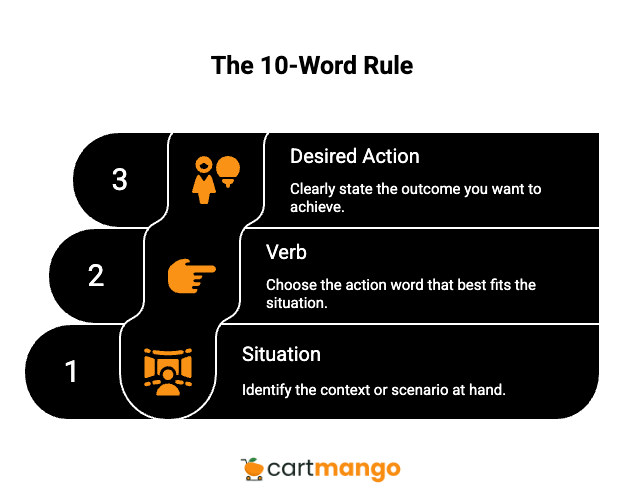
<10-Word Cue Builder
Field | Example (Life) | Your Turn |
|---|---|---|
Situation | Morning routine | |
Verb | Block | |
Desired Action | phone until journaling done | |
Final Cue | “Block phone till journaling’s done.” |
Here’s another useful exercise to sharpen your communication:
Verbose → Crisp
Coaching Niche | Verbose Command | Crisp Rewrite (<10 w) |
|---|---|---|
Sales | “Could you perhaps shorten that benefit statement?” | “State the benefit in one line.” |
Health | “Try adding two extra glasses of water tomorrow.” | “Drink two extra glasses tomorrow.” |
Parenting | “It might help if you acknowledge feelings first.” | “Acknowledge feeling before advice.” |
Try opening every call session with a one-sentence outcome statement. “Today we’re creating your 90-day client acquisition plan.” Clients immediately know where they’re heading.
Business coaches who work with overwhelmed entrepreneurs should pay attention here. When your client is juggling fifteen priorities, your job isn’t to add complexity. Cut through the noise with laser-focused directions in your coaching conversations.
Core Skill #3: Non-Verbal Mastery

Here’s what many coaches miss: body language accounts for 55% of communication impact, tone carries 38%, while your actual words only deliver 7% of the total message.
Video calls amplify these effects. Position your camera at eye level so you’re not looking down at clients. Fill two-thirds of the frame with your head and shoulders. Lean slightly forward to show engagement.
Try this 5-minute audit next week. Record yourself during a practice session. Watch it back and count how many times your gestures match your words versus when they contradict each other.
A relationship coach could be crossing his arms every time clients discussed vulnerability. His body language was shutting down the exact conversations he wanted to encourage. The solution is to keep palms visible and open, creating trust.
Research on body language in professional settings shows that mismatched verbal and non-verbal cues confuse clients and slow progress (Source). When you say “I believe you can do this” while looking at your notes, clients feel your doubt.
- Keep your posture open.
- Make eye contact with your camera, not your screen.
- Match your facial expressions to the emotional tone clients need from you.
Asking Powerful, Open-Ended Questions
Most coaches ask questions that lead nowhere. “How are you feeling?” gets you surface-level responses that waste session time.
Try this instead (from here):
- Tell me more about…
- Explain what happened when…
- Describe the moment you realized…
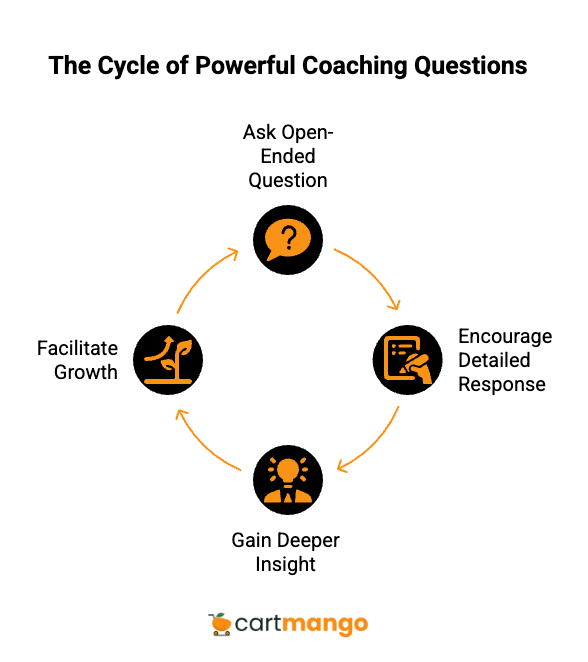
Closed → Open Question
Scenario | Closed Question | Open Upgrade |
|---|---|---|
Business KPI miss | “Did you hit it?” | “What helped or hindered hitting it?” |
Relationship conflict | “Are you upset?” | “How would you describe what you’re feeling?” |
Finance budget slip | “Did you overspend?” | “What drove the spending choices?” |
Master the 2-second pause after asking. Your instinct will be to fill silence, but that pause gives clients space to think deeper. Keep a sticky note on your monitor with “What” and “How” starters to remind yourself.
When a client gives you a one-word answer, your next question should dig deeper. “Frustrated” becomes “What part of this situation feels most frustrating right now?”
Ask questions that uncover beliefs, not just facts. Questions like “What would have to be true for this to work?” reveal mental blocks you can address.
Delivering Constructive, Future-Focused Feedback
According to Harvard Business Review, high-performing teams have an average ratio of 5.6:1 (nearly 6 positive comments for every negative one).
Use the “What-Why-Next” formula for every piece of feedback:
- State what you observed
- Explain why it matters
- Offer 1 specific next action
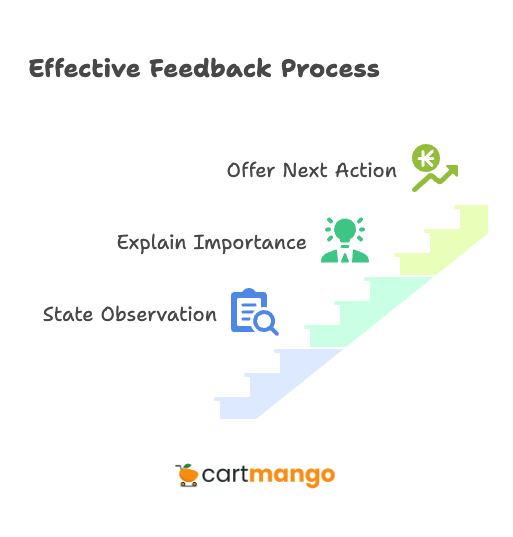
Here’s how it sounds with a sales coach:
“I noticed you rushed through the pricing conversation (What). When prospects feel pressured, they shut down and look elsewhere (Why). Next week, practice stating your price then staying silent for ten full seconds (Next).”
Health coaches can apply this same structure:
“Your food diary shows emotional eating patterns every Tuesday (What). Stress eating derails your energy goals and makes Thursday workouts harder (Why). This week, schedule a 10-minute walk after Tuesday meetings instead of reaching for snacks (Next).”
Timing matters more than you think. Deliver feedback within 24 hours while the situation is fresh in both your minds. Waiting a week dilutes the impact and forces clients to reconstruct what happened.
The key is keeping feedback future-focused. Instead of dwelling on what went wrong, point toward what they’ll do differently next time.
Building Empathy and Psychological Safety
Your clients need to feel safe before they’ll share what’s really holding them back. This starts with how you respond to their initial disclosures.
Replace advice-giving with validation phrases. When someone says “I can’t stick to anything,” respond with “That sounds exhausting” instead of “Have you tried habit stacking?”
Try running a one-word “Feelings-First” check-in at the start of your coaching program. The client shares their current emotional state in one word. This simple practice increases disclosure quality by giving permission to be human.
The deeper your clients trust you, the richer data you get to work with. Surface-level sharing produces surface-level results.
According to Brené Brown, connection happens when coaches reflect feelings accurately, not when they try to fix problems immediately. Emotion labeling beats solution-offering every time.
Handling Difficult Conversations & Conflict
Every coach faces moments when they need to address broken agreements, missed payments, or boundary violations. The key is preparing before emotions run high.
Use this prep sheet for any sensitive conversation:
Difficult Conversation Prep Sheet
Section | Action-oriented prompt | Example entry |
|---|---|---|
Desired Outcome | State the single, specific result that will signal success. | Agree on a 24-h cancellation policy. |
Evidence of the Issue | List two factual observations (dates, numbers, quotes) without blame. | Missed 3 sessions last month: 3/5, 3/12, 3/19. |
Impact on Coaching Goals | In ≤15 words, describe how the behaviour derails progress. | Missed sessions delay habit-building by a week. |
Non-Negotiables | Write up to two boundaries you must maintain. | 1. Same-day cancellations count as used. 2. Max 1 reschedule/month. |
Rapport-Building Opening Line | Craft a neutral, goal-focused opener that links topic to client goals. | “I’d like to talk about our scheduling so you keep on track with your goals.” |
Curiosity Questions | Draft three open-ended “What/How” questions to explore root causes. | 1. What comes up before you cancel? |
Collaborative Solution Ideas | Brainstorm two options that respect both parties’ needs. | 1. Shared calendar with backup slots. |
Next-Step Agreement | Specify who will do what by when. | Client signs revised schedule by Friday; coach sends reminders. |
Follow-Up Checkpoint | Set an exact date/time to review the plan’s effectiveness. | Review in one month on 4/10. |
Language swaps matter during these conversations. “You always cancel” becomes “I’ve noticed three cancellations this month.” Facts feel less attacking than accusations.
A finance coach dealing with missed payment plans might say: “Our agreement included monthly payments by the 1st. I want to understand what’s making that timeline challenging so we can find something that works for both of us.”
Continuous Improvement Plan
Tracking your communication progress requires structured reflection.
Use this tool to help you:
15-Minute Weekly Comms Audit
Prompt | Example note |
|---|---|
Biggest win | “<10-word cue ‘Email draft by 5 p.m.’ worked.” |
One misfire & trigger | “Over-explained budgeting; client overwhelmed.” |
Insight | “Pause, ask ‘What feels unclear?'” |
Next-week tweak | “Add a 30-sec summary at the 15-min mark.” |
Run quarterly 360-degree surveys. Ask four Likert-scale questions about clarity, listening, and helpfulness. Include one open question: “What’s one thing I could communicate differently?”
Building Stronger Coaching Relationships
Effective communication forms the foundation of every coaching relationship, but many coaches also get this wrong: they think communicating means talking more than the client.
Great communication is a two way street. The best coach I know spends 70% of each session practicing active listening and only 30% providing answers. Clients achieve breakthrough results because the coach creates a safe space for self discovery instead of just providing answers.
Strong communication skills require you to challenge assumptions about what clients need to hear. When you actively listen for deeper understanding, you’ll catch the real issues hiding behind surface problems. A supportive environment emerges naturally when clients feel heard.
Poor communication destroys coaching relationships faster than any other skill deficit. Technical aspects like camera angles matter, but the ability to create new perspectives through understanding trumps everything else.
Other coaches often mistake talking for communicating. Real communication strengths show up when you enhance the process by staying aware of what clients aren’t saying. This knowledge becomes your competitive advantage in building confidence and trust.
Your coaching experience grows stronger when you focus on continuous learning about communication means and methods that work.
What Next?
Your coaching success comes down to 3 skills:
- Active listening (track your scorecard)
- Concise instructions (follow the 10-word rule)
- Non-verbal mastery
Pick one skill to focus on in your next client session. Log the results in your weekly audit sheet. Rinse and repeat until you master all three.
The coaches who master these fundamentals create the breakthroughs their clients are paying for.
Related
- SamCart vs ClickFunnels: The Recurring Revenue Hostage (2026)
- SendOwl vs ThriveCart: Which has a hidden trap in 2026?
- SendOwl vs SamCart: The Recurring Revenue Jail (2026)
- ThriveCart vs ClickFunnels: When more features hurt (2026)
- SendOwl vs Payhip: The “You-Leave-You-Lose” Model (2026)
- SamCart vs Kajabi: The Income Hostage Trap (2026)
- Sellfy vs Payhip: The Recurring Revenue Prison (2026)
- Podia vs Gumroad: The Recurring Revenue Handcuffs (2026)
- SendOwl vs Gumroad: The Recurring Revenue Black Hole (2026)
- Gumroad vs Sellfy: The Vendor Lock-in Cage (2026)
